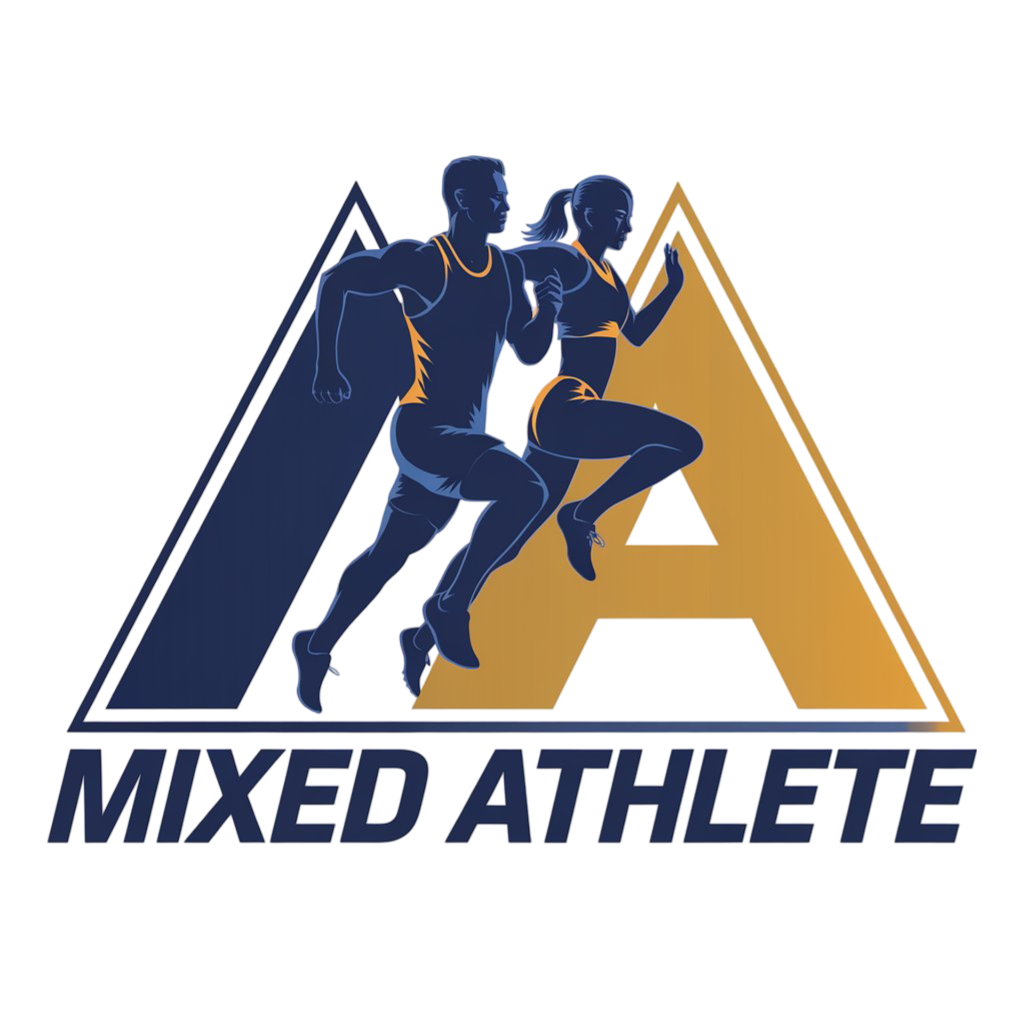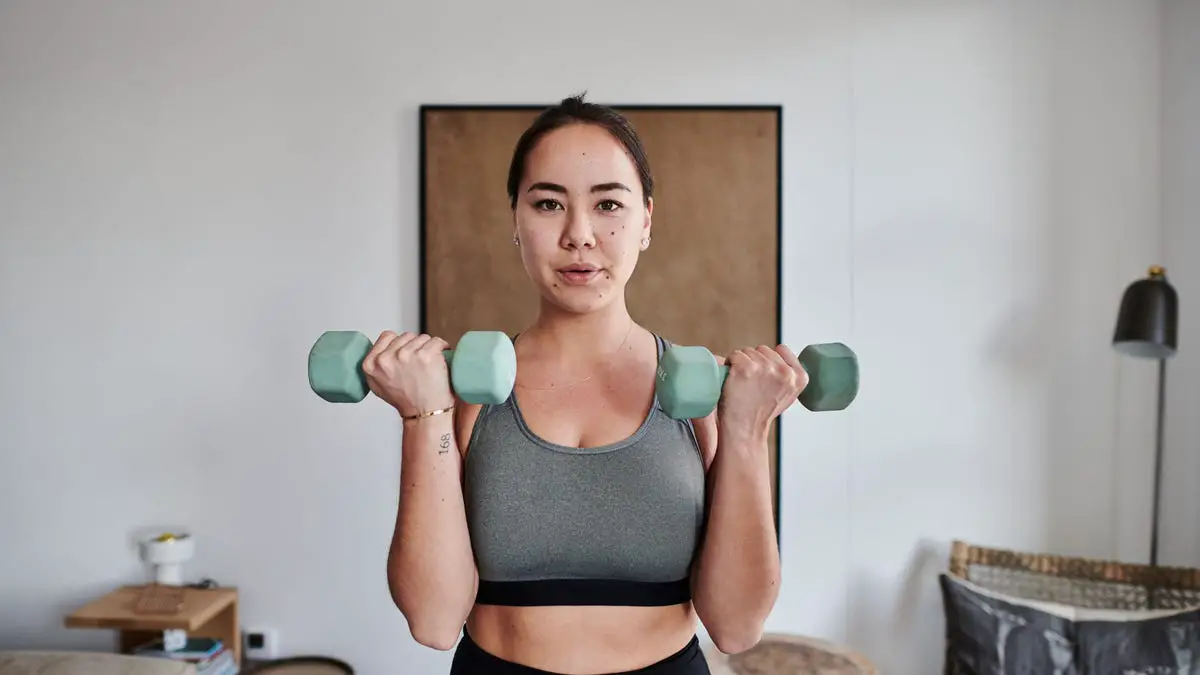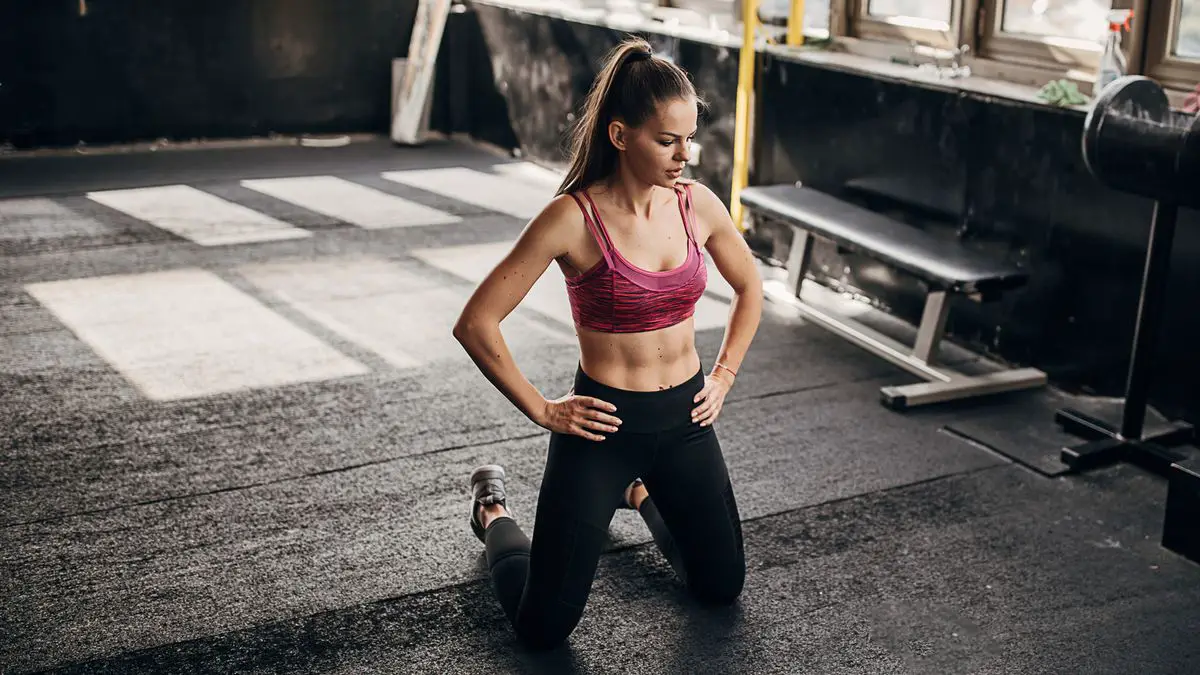Many wellness experts recommend strength training as part of a healthy exercise routine and for good reason. Strength training has been shown to help you age gracefully, get stronger and can even aid in weight loss — if that’s your goal. But what if you don’t know where to start and need some guidance? If you’re looking to focus more on your strength training goals this upcoming year, whether you’re new or have dabbled, there are methods that can guide you if you plan on sticking to this commitment.
Depending on your goals, there are different ways to approach strength training, but it’s key to have the basics down beforehand. Even though I have some experience from my days as a personal trainer, I spoke with additional experts to come up with an easy-to-follow guide if you are a beginner in strength training.
The basics of strength training
If you’re unfamiliar with strength training, this form of exercise — also known as resistance training — involves using free weights (also known as dumbbells), resistance bands or your own body weight to create muscular contractions in order to help you build stronger muscles. Before you get caught up in the nuances of strength training, it’s important to understand the basics of how to start and what you should be doing.
“If you are new to strength training, the first objective would be to create a plan around your specific goals,” says Jahkeen Washington, certified personal trainer and owner of Harlem Kettlebell Club. He says this includes how often you plan to work out and what you can physically tolerate. This approach will keep you from overtraining, help set realistic objectives toward your goal and reduce the risk of injury.
Thomas Summers, founder of Summers Method Performance and a professional strength and conditioning coach, agrees with Washington’s approach and adds, “Understanding the basics of form and technique is crucial to prevent injuries and build a strong foundation.”
As far as how often you should strength train, ideally, you want to start with two days a week or however many days you find allows you to be consistent. “The goal would be to ultimately get at least three days of strength training into your routine, accumulating 150 minutes,” explains Sean Pastuch, certified personal trainer and CEO of Active Life. At least 150 minutes of moderate-intensity physical activity is also what the CDC recommends. However, Pastuch advises taking your time to get to that point and instead focusing on stack wins along the way. And you can’t forget the importance of rest days because that’s the period when your body is recovering.
“Someone starting out may experience more soreness and fatigue after sessions, and that may result in needing more recovery time built in before training again,” explains Washington, adding, “It is much safer to start with less days and safely progress once training tolerance has increased.” Remember, soreness isn’t indicative of a “good” workout. Instead, it’s the effects of delayed onset muscle soreness that occurs 24 to 48 hours after doing a workout your body isn’t accustomed to.
For a program to be most effective, Washington recommends sticking to it for at least four to five weeks before changing it up. This way, you can practice the movements through consistent habits, improve your technique and form and increase your strength and confidence.
How to begin strength training
Lifting weights and performing strength training exercises is the most effective way to build muscle.
Now that you understand the strength training basics, we can focus on how to begin. Unless you have a personal trainer by your side, chances are you may not know how to structure a proper strength training program for yourself. Washington prefers full-body workouts for beginners since they allow individuals to train various movement patterns and gain strength across multiple body parts. Summers says full-body workouts hit all major muscle groups without overcomplicating things. “This structure also helps build strength and endurance,” he adds.
When it comes to exercise selection, Washington relies on these six foundational movement patterns. Keep in mind there are many other exercises that fall under each movement pattern, but these are just some examples:
Movement
Exercise example
Hinge
Deadlift
Squat/Lunge
Goblet squat/Split squat
Upper Body Push
Push ups
Upper Body Pull
Bicep curls
Carry
Farmer’s carry
Core
Plank
| Movement | Exercise example |
|---|---|
| Hinge | Deadlift |
| Squat/Lunge | Goblet squat/Split squat |
| Upper Body Push | Push ups |
| Upper Body Pull | Bicep curls |
| Carry | Farmer’s carry |
| Core | Plank |
Glossary of exercise examples:
- Deadlift: The deadlift is considered a compound exercise that works the whole body using a hinging motion at the hips to lift weight up and down. The main muscles it targets are the glutes, back, hamstrings and quadriceps. You will usually see the deadlift listed as a lower-body exercise. The deadlift also has different variations and can be done using a set of dumbbells, kettlebells or a barbell.
- Goblet squat: The goblet squat can be done with a single kettlebell or dumbbell. The weight is held in front of your chest with both hands and elbows close to the body, forcing you to keep your body upright and core tight as you come down in a squat. This exercise targets your glutes, quadriceps and core muscles.
- Split squats: The split squat is another lower-body exercise that involves good balance since it challenges each leg individually. There are variations of this exercise as well, but in general, the split squat has you standing on the floor with one leg in front and the other in the back and challenges your stability as you bend both knees to go down and come back up. It resembles a lunge, except your back leg remains in place as you go through each repetition. You can hold a pair of dumbbells or kettlebells, one in each hand, to make it more challenging, use body weight and even hold a barbell with added weight on your back. This exercise can help you build single-leg strength and targets your glutes, hamstrings, quadriceps and calves.
- Push-ups: Push-ups are an upper-body exercise that can be effective without weight, especially if you are new to the exercise. The push-up also has different variations (on your knees, tricep, diamond, wide, incline, etc.) depending on your fitness level and the muscles you’re trying to target. Overall, you are working the chest, shoulders and core muscles. I personally like incline push-ups (where you use an elevated surface like a table or bench) for beginners because it sets them up in a similar position to a push up on the floor and allows them to get deeper into the movement.
- Bicep curls: Bicep curls commonly use dumbbells, resistance bands, kettlebells, cable machines or barbells. There are many variations of bicep curls as well. Generally, dumbbells are one of the most popular ways to do bicep curls and involve starting with a pair, one in each hand, with your arms by your side and palms facing forward. To do a bicep curl, you have to bring the weight up toward the shoulders by bending at the elbows, making sure the elbows stay close to the sides of the body. The bicep curl targets your core, biceps and forearm.
- Farmer’s carry: The farmer’s carry, also known as the farmer’s walk, is a full-body exercise meant to have you practice carrying a heavy load across a straight distance for an allotted time — usually a minute. It targets your glutes, back, core, biceps, triceps, calves, hamstrings and especially challenges your forearm and hand muscles since grip strength is crucial. To do a farmer’s carry, you have to hold two heavy dumbbells (this will vary per person) by your side (picture like you’re carrying grocery bags) as you walk across a room. The idea is to remain upright (no slouching) and in control as you walk with the extra weight.
- Planks: The plank is a core-centric exercise with different variations. Traditionally, it is done with your forearms on a mat, elbows under your shoulders and your body forms a straight line from your head to your feet. You can hold it anywhere from 30 seconds to a minute or longer. It works all your core muscles including your upper and lower body.
“If you pick one movement from each category, you have a very efficient and well-put-together session that touches on all your needs,” Washington says. This is similar to the programming I was taught when I was a personal trainer and had to come up with programs for clients. It’s an efficient way to learn what body parts specific exercises target and how to properly pair them according to your training day — without the cost of a personal trainer.
If you’re creating your own program, Summers recommends focusing on compound lifts — like deadlifts, squats or push-ups — which work multiple muscles at once. “This ensures you’re hitting each muscle group at least once a week,” Summers says. Additionally, he advises tracking your progress and adjusting as needed. A good way to track your progress is to keep a gym journal where you can jot down the weights you’re using, the sets and repetitions per exercise during your training sessions.
Repetitions are the number of times you can do an exercise movement within a set. A set is the group of repetitions of an exercise you do without rest. However, you can and should rest between sets.
The right strength training equipment
Home exercise equipment helps make getting a workout in easier during the week.
Knowing the types of fitness equipment to have on hand is key. “For beginners, I always recommend a mix of machines, dumbbells and kettlebells, depending on what they have access to,” says Washington. These are safer alternatives to a barbell, which requires more strength and good technique before taking it on. The aforementioned pieces of equipment are also a good way for beginners to get familiar with the movements and make progress.
Summers prefers dumbbells as well as machines that mimic natural movement patterns. “Squat racks are great for barbell exercises, while the Smith machine can be useful for beginners needing stability,” Summers says. A squat rack is a piece of fitness equipment made up of steel frames that hold barbells and can be used for squatting, bench pressing, overhead pressing and more. The arms on a squat rack are meant to hold the barbell when it’s not in use and work as a spotter when you’re lifting. A Smith machine looks identical to a squat rack, but it offers more assistance and stability since the bar remains fixed on a track. It glides up and down when it’s in use.
If you’re solely working out at home, Washington recommends investing in a pair of adjustable dumbbells, resistance bands, kettlebells and a pull-up bar. “I am a firm believer that less is more when it comes to training,” he says. If you are training with the different movement patterns and putting in the effort, you will be able to see results from your hard work.
Types of strength training equipment:
- Dumbbells: Also known as free weights, dumbbells are individual weights designed with a short bar and equal weights on each side. They come in various weights ranging from three to 100 pounds or more. Depending on the size of the weight, they are an affordable option to have on hand. You will most likely spot these on a rack in size order at the gym.
- Kettlebells: Kettlebells have a bell-like form with a grip handle on top, known as the horn. Kettlebells are usually made out of cast iron, but you may see some that are vinyl-coated (ideal if you’re looking to protect your floor). Although kettlebells can look intimidating, they are beginner-friendly and can make learning certain exercises like squats and deadlifts easier than using dumbbells or a barbell. As you become more experienced with kettlebells, you will learn that technique is key to keeping you safe and getting the most out of this piece of equipment. These are some of our favorite kettlebell picks if you want to stock up on any at home.
Kettlebells can be used for strength and cardio training.
- Barbells: Once you’ve become familiar with the basic strength training exercises and are ready to progress equipment, the barbell is the next step. It’s a long straight bar made out of metal that is usually around five, six or seven feet long. You will most likely see these on squat racks on a deadlift platform (if your gym has one). On its own, a standard barbell, depending on its length can weigh between 25 to 45 pounds. It’s meant to hold round weight plates (you’ll usually see them in black or various colors) on each side of the bar. Barbells can hold a lot of weight, making them the ideal tool to help you get even stronger once you’ve mastered the basics.
- Adjustable Dumbbells: Adjustable dumbbells are space-saving weights that can replace dumbbells if you don’t have room for them. Adjustable dumbbells come in different designs, but the one thing they have in common is that you can increase or decrease the weight with a turn of a dial, a press of a button or a twist of the handle. One set of adjustable dumbbells usually comes in five to 50-pound weights with five-pound increments. Some brands offer heavier weights if you prefer. Check out our favorite adjustable dumbbells if you are looking for ideas to begin.
- Squat racks: A squat rack is a piece of fitness equipment made up of steel frames meant to hold barbells and round weight plates on each side. It can be used for exercises like squatting, bench pressing, overhead pressing and more. The arms on a squat rack are adjustable and meant to hold the barbell when it’s not in use and as a spotter when you’re lifting. These are some of our top picks if you are considering purchasing a squat rack.
- Smith machine: A Smith machine looks identical to a squat rack, but it offers more assistance and stability since the bar remains on a fixed steel track. It glides up and down when it’s in use and hooks onto the frame when you are done with your repetitions. This machine is helpful to practice exercises like back squats before transitioning to a squat rack.
- Resistance bands: Resistance bands are an inexpensive option for strength training and good for beginners. You’ll see that resistance bands come in various weights, long and short lengths and some have handles. Longer resistance bands are ideal for doing exercises like bicep curls, deadlifts and overhead pressing, to name a few. The shorter resistance bands are best for lower-body workouts like squats, reverse lunges or lateral band walks. These are some of our top picks for resistance bands if you plan to add them to your strength training regimen.
How to choose the right weights
There is a rule of thumb to follow if you are new to weights. Washington says you should focus on repetition ranges to determine the right weights for you. You may want to have a few sets of dumbbells of different weights (for example, 5, 10 and 15-pound dumbbells) on hand to determine a pair that feels easy yet challenging enough for you.
“You should make sure that the last two to three repetitions of any exercise are much more challenging than the first reps you do with the weight you’re using,” Washington explains, adding, “So, if someone asked you to complete a set of 10 reps, the last two reps of that set should feel challenging.” For example, if you grab a pair of 10-pound dumbbells and do 10 bicep curls, those last couple of reps should feel more challenging compared to the first five reps. But they shouldn’t be so challenging that you can’t complete them — otherwise, that may be a sign you need to decrease the weight you’re using. Keep in mind that you shouldn’t sacrifice form when executing any exercise.
Strength training is important for weight loss since it helps you increase muscle mass.
Washington recommends sticking to two to four sets per exercise and including two- to three-minute rest periods between sets. It’s important to respect those rest periods so you can make the most out of each set.
How to progress your strength training program
Once you have mastered the key movements and feel comfortable with the weights but want to challenge yourself, there are ways to progress your program. Some easy ways to make an exercise harder is by increasing weight, reps, sets and tempo (controlling the speed of the exercise at hand). These are ways to make progress without changing the equipment you are using.
You’ll know you’re ready to move on to a more advanced piece of equipment if you have successfully been lifting the weights you have for a while and no longer feel as challenged.
“One major reason to move away from a piece of equipment is if the loads offered are no longer heavy enough to support your strength goals,” says Washington.
For example, if the max weight you have is a 50-pound dumbbell, and you are able to squat it 20-plus times with ease, it would benefit you to introduce a new squat variation that provides heavier loads where you can squat eight to 12 times instead. If you have been mainly using dumbbells, you could swap them for kettlebells or, eventually, barbells. Summers advises progressing to barbells when you feel confident with your form using lighter weights. He says, “If you’re consistently hitting your rep targets with dumbbells, it’s a sign to step it up.”
The same applies if you’ve only been using machines at the gym — you can change things up by transitioning to dumbbells. Your body will thank you for offering it a new stimulus. Washington says when you introduce a new piece of equipment, you can follow the same process of exhausting all your techniques before switching things up again.
“You can start looking at advanced techniques that are offered like 5-3-1 [a method used to help you get stronger over time], drop-sets [a method where you lift as many reps as possible until failure and then decrease the weight each set after] and supersets [doing a set of two different exercises back-to-back with minimal rest in between] exercises, to name a few,” Washington explains. These lifting strategies challenge you in different ways but will help you as you look to progress your training.
Strength training terminology
These are some key strength training terms and some of the many ways a strength training program may be designed.
Sets: A set is the group of repetitions of an exercise you do without rest. Usually, you will see a program ask you to do three sets (unless otherwise specified) of a certain number of repetitions. For example, a program may read: 3×10 squats. This means doing three sets of 10 squats. You’ll do one group first and then repeat that two more times for a total of three sets.
Reps: Reps or repetitions refer to the number of times you do an exercise within a set. Using the previous example, 3×10 squats, 10 is the number of reps you’re doing for this exercise.
Rest period: Every strength training program usually includes a rest period between sets, unless otherwise specified. Rest periods can range from one to three minutes or as little as 30 seconds between sets. This will depend on your goal. Longer rest periods are better for building strength, whereas shorter rest periods are better for building endurance. During a rest period, you should focus on resting, not trying to fill up that time with other exercises.
Drop sets: This is a method of strength training where you lift a specific weight for as many reps until you can’t complete another repetition in one set. You then decrease the weight by 10% to 30% each set thereafter with no rest in between sets. For example, we’ll do 20% less or so for each of the following sets. There is no rest in between these sets.
Squats: Set 1: 25 pounds for six to eight reps
Set 2: 20 pounds for 10-12 reps
Set 3: 15 pounds for 12-15 reps
Supersets: This time-saving strength training technique allows you to tackle two different exercises back-to-back with little to no rest in between. Often a superset includes exercises that work opposite muscle groups. Example of an upper-body superset:
Exercise A1: Bicep curl (a pulling exercise) 3 x 10-12 reps, rest: 30 seconds per set, then go on to exercise A2
Exercise A2: Push-up (a pushing exercise) 3 x 10-12 reps, rest: 1 minute, go on to the next set of exercise A1.
Tempo: A tempo strength training workout involves using time under tension as you lower or lift the weight during an exercise. This could be done rapidly or slowly. You’ll probably see most programs tell you to do an exercise slowly using a count of three to four seconds on a specific part of the movement.
This could be during the concentric (the part of the movement that shortens the muscle like the lowering portion of a squat) or eccentric (the part of the movement where the muscle lengthens like the return to standing position part of the squat) part of the movement. For example: Doing a deadlift slowly with a three-second lowering count and returning to the starting position quickly on the fourth second.
How cardio fits into a strength training program
Jumping rope is a highly effective cardio workout.
A well-balanced overall workout program should also have cardio in addition to strength training. How much cardio you do will vary based on your goals. If you are looking to get cardio in to maintain your health, it’s going to look different than if you are training for a race that requires more of a focus on building your aerobic endurance.
Pastuch recommends that everyone go on at least one 20-minute walk every day. “If you are unable to complete a 20-minute walk continuously, work to accumulate 20 minutes of walking throughout the day; this counts as cardio,” he says. For people looking for a more intense workout, he recommends including one day of high-intensity cardio per week. You can aim to do no more than 30 minutes of high-intensity cardio to reap the benefits.
Washington approaches cardio as a part of your strength training day, either before or after your session if you can manage it. “My personal preference is 15 to 30 minutes, depending on time commitment,” he says. He also suggests doing cardio on separate days. “You can split between two strength days and two cardio days because this gives you more flexibility with how much time you can dedicate to cardio,” Washington says.
Takeaway
As you can see, it’s possible to get started with strength training without getting overwhelmed. If you start off simple and work slowly towards your goal, you’ll develop newfound confidence and strength from all the work you’ve put in. The best part about this sport is that you don’t have to compare yourself to anyone other than yourself. Take your time and know that there will be times when you don’t feel motivated and times when you’ll be super charged up.
Additionally, don’t be afraid to ask for help if you are ever questioning your form with a specific exercise or if you’re trying to learn a new technique. You’d be surprised how many experienced lifters at the gym or trainers are willing to lend a helping hand.





